Around the U.S. and the world, people carry guns. If they are not working in an overt context, whether legal or not, they will endeavor to conceal the gun, usually a handgun.
They could be another armed citizen going about their day, possibly like you, an off-duty or undercover police officer, or a criminal scumbag or gang member keeping his tools of the trade in a ready condition.
Whoever you might be, consider learning the sometimes subtle tells that indicate the presence of a concealed weapon as part and parcel of enhancing your situational awareness.
You will not always be able to discern the presence of a weapon, especially a knife, but you often can with enough practice. Discerning the presence of a weapon is one thing, discerning someone’s intent is another.
However, in conjunction with certain behavioral and social cues, the fact alone that a certain character is unarmed may be enough of a reason to vacate the area or at least give them a wide berth.
In this introductory article I will explain the different types of signals or cues that may indicate the presence of a weapon, as well as additional considerations you may wish to incorporate into your own carry practices to reduce your profile.
Table of Contents
Indicators: The Symptoms that Point to “Weapon”
Indicators are simply signs that point to a likely presence of a weapon. Indicators come in two broad varieties: behavioral indicators and presence indicators.
Behavioral indicators are things that the person does because they are carrying a weapon. This could be something done to the weapon itself, or because of psychological stress or worry by the carrier over it.
Presence indicators are from the weapon itself. These are things like, bulges, printing or sagging of clothing, or abrasions characteristic of carrying a weapon in the same location consistently. I’ll detail the most common indicators in both categories in the next section.
Indicators can run the gradient from very subtle tells or physical tics like a subtle shift in a garment, to blatant, neon billboard-obvious displays like the gun or knife being revealed after concealing garment failure.
Many times one or two subtle indicators alone will not be enough to say for certain someone is concealing a weapon, but in conjunction with analysis of their attitude and the setting it may be enough for you to make the determination that they are a “probable” carrier.
The type of weapon makes a big difference in how easy it is to hide and, ergo, how easy it can be to spot. Compact handguns and larger can be easy to spot owing to their weight, distinctive shape, and likelihood of being placed in only a handful of locations on the human body.
Typical long guns are difficult or impossible to conceal owing to their length and bulk if not carried in a piece of luggage or under the stereotypical long coat (whose presence is often an indicator all by itself).
Knives are different; low profile, much lighter than a pistol and easy to conceal well compared to any guns, a small knife is very easy to hide even in the wielders hand until it is too late to detect. This is a big part of what makes knives so dangerous.
Most of the indicators discussed in this article will be applicable to any weapon, but will present most often with a pistol. Knives are often small and unobtrusive enough to not engender too much fussing on the part of their carrier and many will ride invisibly in a pocket or waistband until drawn. I will make mention in the specific sections if one indicator applies specifically to a certain kind of weapon.
The Fundamentals of Concealment
Concealment can be achieved in a variety of ways, both on and off the body, but for our purposes in this article we will look at the prime factors that help dictate an individual’s placement of a weapon on their body.
The very first is which hand they use, their “handedness” or dominant hand. It is an extremely high probability that any given person will use their dominant hand to both acquire and employ a weapon.
An easy assumption will be the right hand, as most earth dwellers are. But, as with all things, we should not assume, even on a safe one.
Watch their hands: which one are they holding their phone with? Which side do they keep their wallet on if in a store, or eat with in an eatery? A less reliable tell is a wristwatch, as they are often worn opposite the master hand.
Once you have made that determination that will inform the likely location of the weapon on their body if carried on body.
Right-handed gun carriers will likely carry somewhere on the right hemisphere of the beltline between 12:30 and 6 o’clock, in a right side pocket in their pants or jacket, under the left armpit in a shoulder holster or on the left ankle if in an ankle holster. Reverse all of that for lefties.
Knives will be carried in similar locations, most commonly seen clipped in a pocket or in a sheath on the beltline, close at hand. Note again knives are easy to hide, and can be strapped to a forearm under a sleeve, hanging by a cord around the neck and in a dozen other, inventive and invisible locations.
Once you have determined an individual’s handedness, move on to looking for indicators. If unable to determine their dominant hand you should simply be looking for indicators on both sides of the body.
Behavioral Indicators
Behavioral indicators are comprised of tells, body language, things done to the weapon or because the weapon is carried. You will often see these when the weapon in question is a gun.
This may take the form of altered movement patterns, shielding the location of weapon from frontal notice of bystanders, or reflexively nervous pats or pulls to ensure a gun remains in place, be it in a holster, stuffed in a pocket or tucked in a waistband.
Some are more overt, and may take the form of the carrier vocalizing the presence of or their willingness to use a weapon during an argument or confrontation, e.g. “I’ll f****** cut you, man!” or “Don’t make me shoot you!”
Obviously, anyone who flashes or acquires a grip on their weapon is obviously armed and should be treated accordingly as the situation dictates.
Below are common behavioral indicators.
The Block
A person carrying a weapon that is self-conscious about it, either from inexperience or nervousness, will often try to keep their body between an oncoming observer. This takes the form of a curious rotation, either of the torso or the whole body in place to block the weapon’s location from direct line of sight.
For instance, a carrier with a gun or knife on their right side will turn to the right when approached head on or standing face to face with someone, thus moving the weapon behind the mass of their body, and out of sight from the nearby person.
A related form happens when someone is moving in for a hug or to put an arm around the carrier; this leads to a quick jig where they will reposition themselves to minimize or eliminate the hugger feeling the weapon of the huggee.
The Block may also take the form of conspicuously positioning anything carried in the hands to one hip or another in order to shield the weapon in the same way.
The Pat
Again symptomatic of new or nervous carriers, even old professional carriers will fall victim to this inadvertently or by necessity after the weapon or garment has been bumped or disturbed.
This indicator takes the form of exactly what it says on the header: a hand patting or brushing the location of the weapon to confirm either its continued presence, concealment status or simply for mental reassurance.
This could be directed to any of the locations above, but rarely an ankle, as that is easily visually confirmed by the carrier.
The Swerve
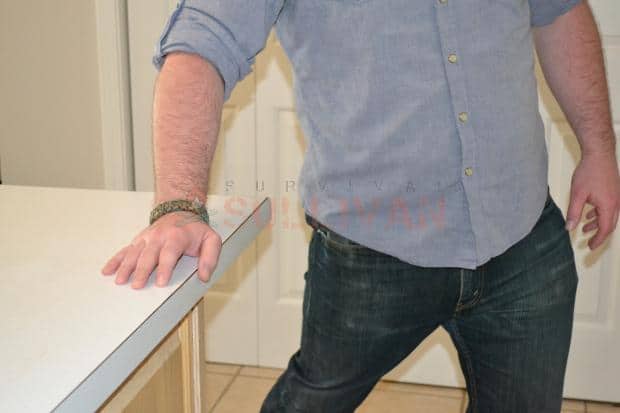
People that carry a weapon on their hip will often develop a movement quirk when in close quarters to people or objects on the side the weapon is carried on: due to the fact that the weapon, especially a gun, again, increases the width of the hips, most carriers will invariably go through a period where the weapon will smack into people, countertops, door frames and the like with a loud clunk or clang until they learn to account for this instance.
Some develop a little swerve or jink where the carrier swings their hips out and away from the obstruction to prevent contacting it with the weapon. It is highly noticeable and odd looking once you know what to look for.
The Adjuster
Often seen when someone is carrying a gun. Even light guns are heavy, and usually uncomfortable. Adding insult to injury, unless carried holstered on a good gunbelt they have an aggravating tendency to slide, shift, rotate and flop in pockets or waistbands.
You’ll see the carrier reach for the gun, furtively or not, grip it, and adjust it to or fro to reposition it in order to increase comfort and security.
This will present commonly when a small gun is carried in a pocket or in the front of the waistband without a holster. This tell is a frequent occurrence when someone is carrying in the waistband with no holster, commonly called “felony carry.”
A Clipped Stride
This one can be subtle. Expect to see someone carrying a gun or large knife on beltline or ankle show a somewhat shorter stride on the side that they have the weapon, i.e. a right handed carrier with the weapon located accordingly will not step as far with their right leg compared to the left and typically not swing their right arm as far as the left arm.
This is much easier to notice if someone is walking perpendicular to you.
The Clamp
Happens when running, clambering or doing anything that may lead to the weapon coming out of pocket, sheath or holster, or the carrier anticipates that this may occur; you’ll see them actually acquire a grip on the weapon, usually through the clothing, to hold it in place.
This is done to secure the weapon against The Drop, discussed later under Presence Indicators. Spoiler Warning: it is exactly what it sounds like.
Reluctance to Bend Over
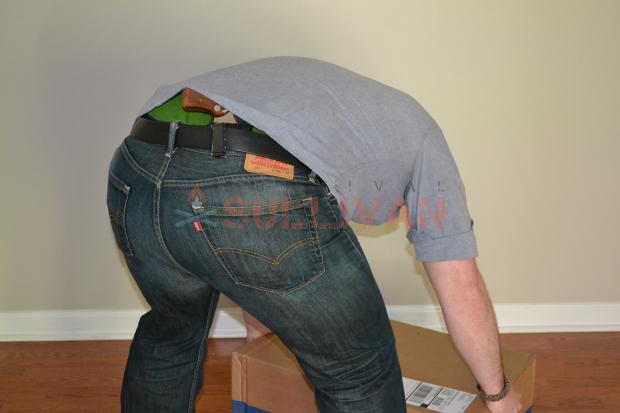
Commonly seen when a carrier has a gun on the beltline between the hip and 6 o’clock. They will not bend over when standing to pick up a dropped item or anything low to the ground, as doing so will allow most garments to shift or stretch, thus revealing the gun to the eye or by severe printing. Watch for them to take a knee or squat instead.
Sure, it might just be bad back, but perhaps not. If you see someone bending over, keep an eye on their waistline and back area and you will easily see a large handgun or sheathed knife printing. Also keep one eye on jacket/coat pockets as a weapon carried there will create a noticeable droop off the body when leaning over.
Unwilling to Remove Concealing Garment
In a setting when a garment like a coat, jacket or similar would be removed, either for wearer comfort or social etiquette, any refusal to do so is suspicious, and indicative of a weapon either concealed at the waist, under the arm or within the garment itself.
This could result from a too warm office or reluctance to remove a coat when sitting down to eat.
Presence Indicators
Presence indicators are signs and cues of the weapon itself. Presence indicators are mostly visual but can be auditory.
They will usually take the form of a disturbance, failure or anomaly in the way a garment looks or behaves on the body, but could also be spotting a piece of support equipment, like a loop or strut on a holster, or the obvious pocket clip of a folding knife.
More subtle, it could be slight damage left on a garment from the aforementioned things: when worn repeatedly, holsters, sheaths and clips will leave small, well-worn signs on otherwise pristine clothing.
These tracks are obvious tells that the individual is a habitual carrier, and you can bet they have a weapon on them then as well, if perhaps in a new location.
Bulging or Printing
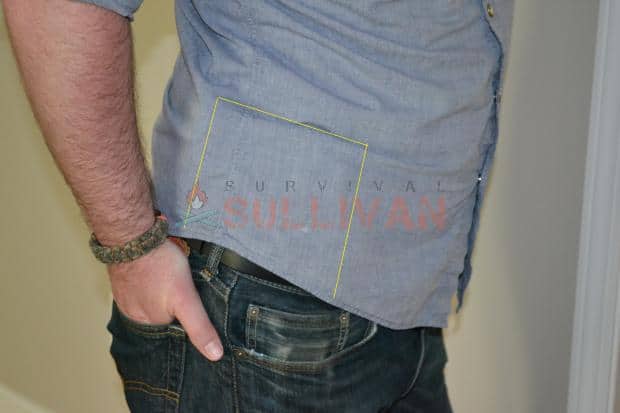
Good examples of a bulge in a concealing garment. In picture No.1, the weapon, a fullsize semi-auto carried IWB is detectable via a the smooth area with the pronounced, straight ridges, highlighted in yellow.
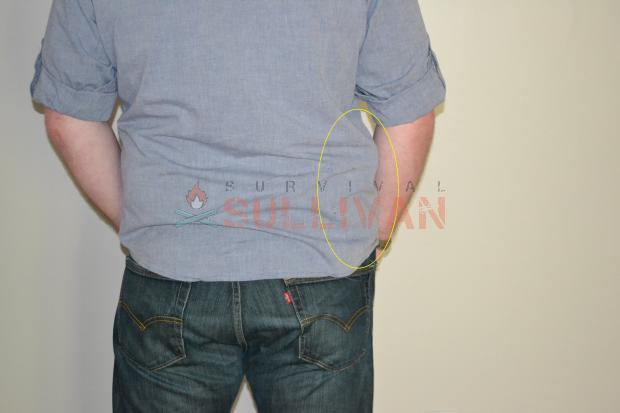
The same gun viewed from the rear. The bottom of the grip is easily seen from the behind.
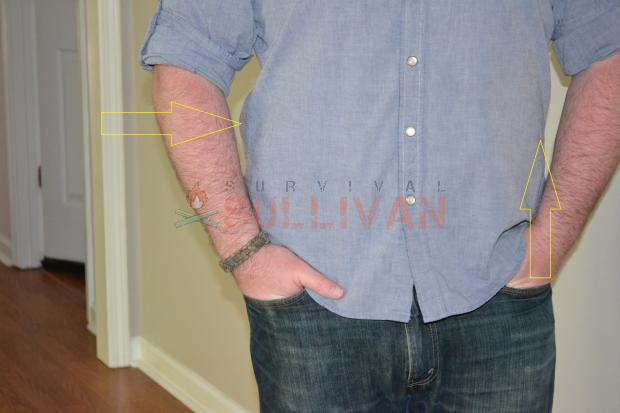
Same gun again, a little harder to spot form the front. Look at the indicated areas on the carrier; you can see a slight flare by his right elbow. That is the grip of the pistol.
The most common and easily spotted indicator, aside from cover garment failure, larger knives and most guns will betray their location by a conspicuous lump through a garment or by showing a ghost outline when fabric is stretched too tightly across it.
Bulging and printing may result from poor carry methodology (placement, holster/belt selection, garment choice, etc.), or the way the carrier is standing, sitting or moves. Check all the proscribed locations mentioned earlier in the article for the symptoms above, and also look out for tightening of fabric across that location.
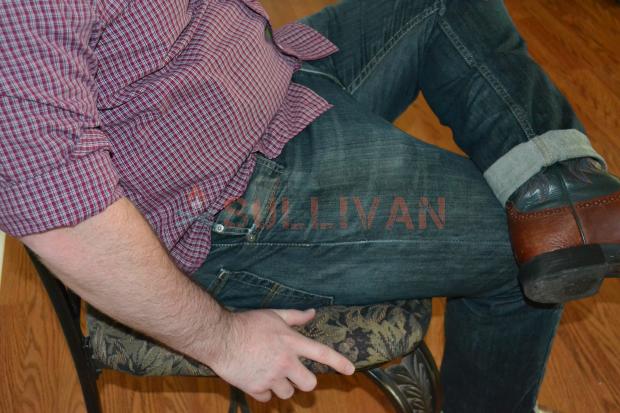
Look closely at the right pocket. See the shape of the compact revolver carried often there? If not, can you notice the much lighter “balding” on the denim?
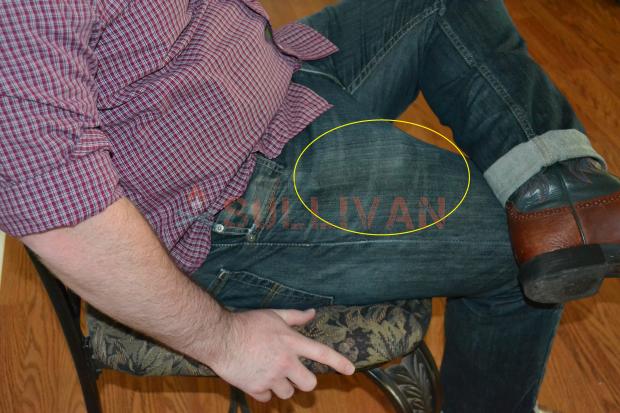
Now highlighted. Gun is a S&W Mod. 36 J-frame.
The pattern, color, weight and type of clothing all help or hurt concealment. Most patterns, especially geometric shapes help hide bulges and printing. Heavy, puffy garments help greatly.
A garment wet from rain or heavy perspiration may not behave as it normally does dry, exacerbating a bulge or by becoming translucent, revealing the outline of the weapon. Wind may press or pull a garment across a gun. A weapon in a pocket made even heavier from wetness will sag precipitously (no pun intended) and be more noticeable than usual.
The Droop
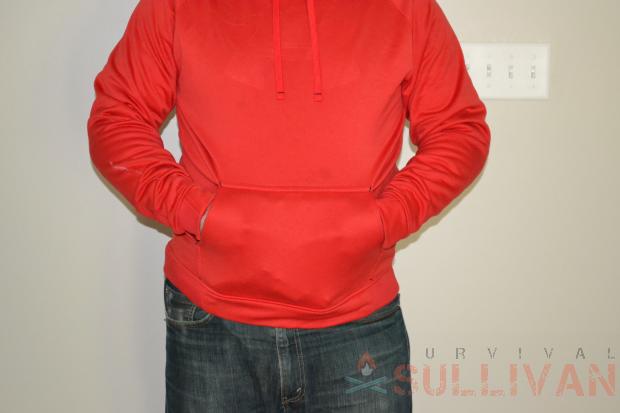
Guns are often carried in jacket pockets or hoodie pouches. This example is flagrant printing and drooping significantly. How does color and texture affect the outcome here? Would a lighter gun be a better choice?
For guns pocket carried in a jacket or pants, unless it is a flyweight gun, you will often see one pocket hanging lower than the other perhaps in addition to printing as described above.
This may also occur on one side of the pants or the other for a heavy pistol carried on the belt, especially OWB. The printing in a pocket can be reduced or eliminated with a pocket holster or flat gun, but unless the carrier is savvy and uses counterweight in the opposite pocket this will betray them.
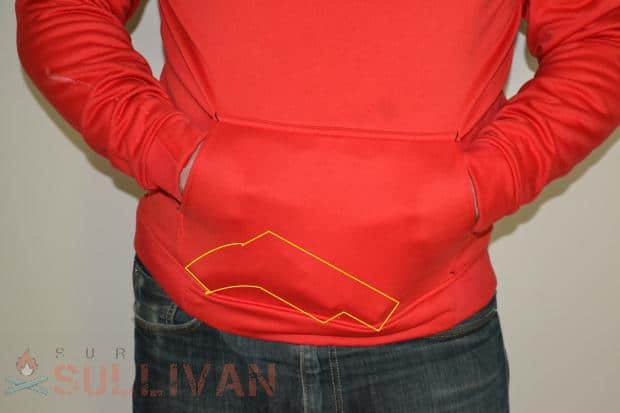
Same picture above, close-up with weapon highlighted. Gun is S&W Mod. 36 J-frame.
Knives are often too light to cause drooping, but some heavier examples will. They are more often spotted in a pocket by printing, or from their ubiquitous pocket clips.
Hardware Sighting
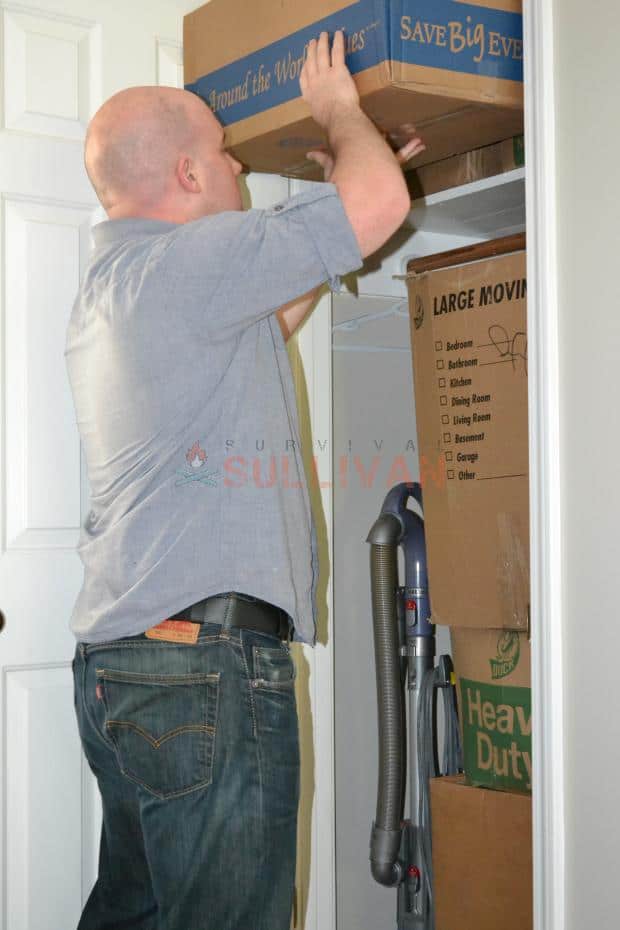
Look carefully here. What can you see?
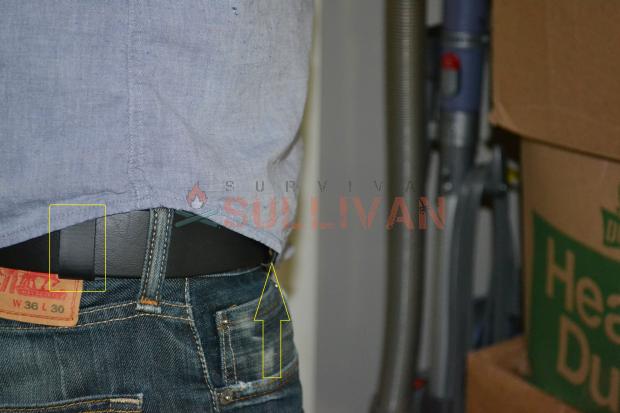
Close-up of above. Low profile loops of holster are indicated. Hard to spot against a like color and texture belt, but still a giveaway. A brown leather holster or colored kydex loops would be much easier to see against the belt. The Devil is in the details.
This comes in two flavors: seeing the weapon itself, or the unmistakable indicator of something used to carry the weapon. For the weapon itself, it could be the result of a garment failure, where it has been hitched or pulled away from the weapon, revealing it to bystanders.
Less obvious but still very visible indicators are things like pocket clips for knives and certain spare magazine carriers as well as loops, straps, clips or hooks placed on or around the waistline and/or belt.
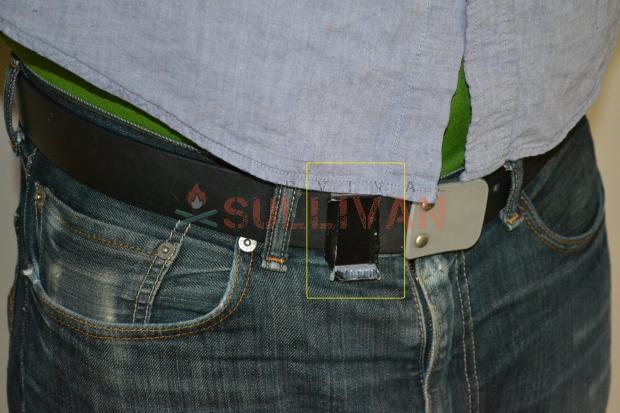
What’s this? Hard to say, a metal clip of some kind. This location is commonly used for carry of weapons, and even though none is visible or indicating through the garment the smart money is on a holster or sheath of some kind.
If you cannot positively ID the mystery attachment, assume it belongs to a holster or sheath.
Unusual Wear
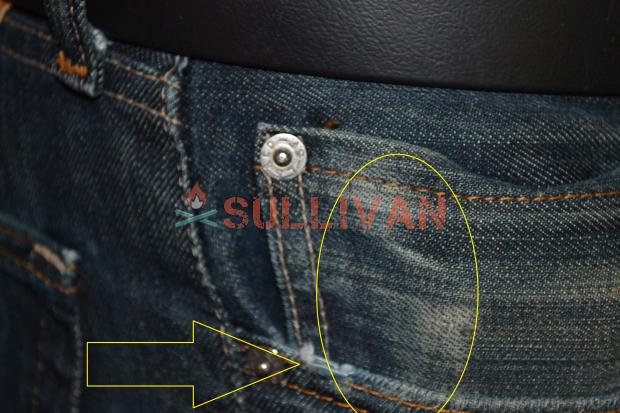
A close-up of the front right pocket of a pair of jeans. Look at the frayed stitching at the arrow and the odd wear in the circle. Both were caused by the habitual carry of a pocket knife.
If you carry a pocket knife with a clip regularly, take a look down at the pocket you carry it in. Notice anything? See that little patch of frayed fabric and loose stitching? That’s our snitch, an indicator even if you don’t have the knife in place.
Same applies for guns; they’ll create unusual, well-defined wear marks on belts and waistbands of pants as well as nibbling little pinholes in concealing shirts or jackets. With a good eye, these wear indicators are easily spotted.
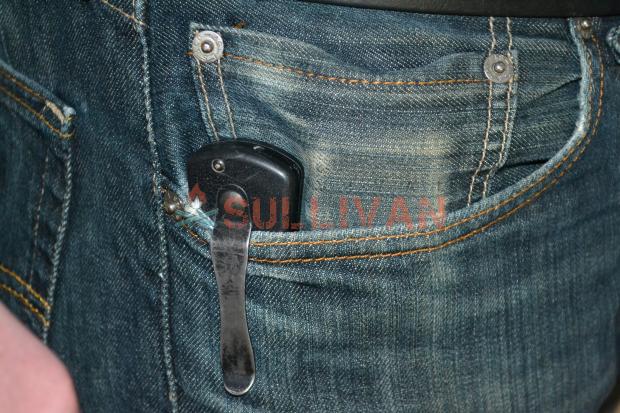
It is clear to see how that happens now: the clip has rubbed the hem of themain pocket, while its presence puts pressure against the Zippo carried in the smaller pocket.
A gun routinely carried in a pocket without a pocket holster will emboss itself through the fabric creating wear where the gun rests. These are very noticeable in jeans or khakis.
The Clunk
My favorite, and the one I am most alert for in a public setting like a restaurant. Anyone who carries a gun, but sometimes a larger knife on or behind the hip who sits down or leans against a hard surface will create a loud, distinctive clunk sound when their weapon contacts the surface they are sitting on. Keep your ears open next time you are at a restaurant and you’ll hear this at least once.
Once you notice this, you’ll start hearing it everywhere. Chances are you do it yourself if you carry a pistol. Don’t be that guy or gal!
The Drop
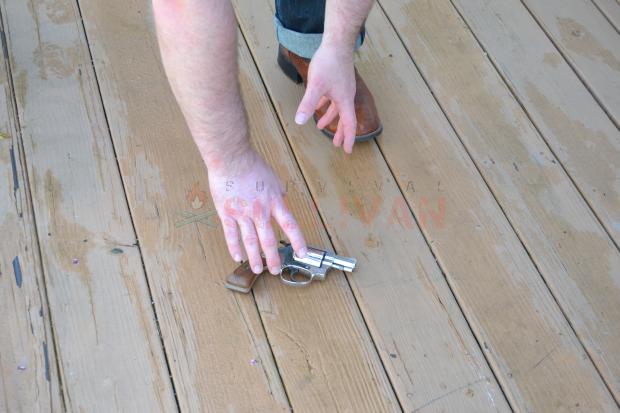
Don’t mind me!
The Dreaded Drop. The Field Goal. The OMG. If this occurs in a public setting, the jig is up, and someone typically needs to leave the premises. This will occur under a few different sets of circumstances, and this assumes the weapon was not in someone’s hand:
1) something snags the weapon and plucks it from the body. It tumbles to the floor.
2) the weapon was poorly secured, usually in the waistband with no holster or sheath and it works free under movement, falling to the floor.
3) the weapon hits the ground at a bathroom stall because the carrier is pulling their pants up or down or removing an upper garment, dislodging the gun. Don’t laugh: it’s shockingly common. Pray it does not happen to you.
If this happens the carrier is usually mortified and, if a good guy, will promptly apologize and head for the exit. This is not a guarantee, but expected behavior to avoid scaring the horses, so to speak.
Luggage Indicators
Detecting a gun in a bag, briefcase, purse or something similar is challenging. Any bag that does not belong in the setting is a yellow flag, especially one large enough to carry a long gun.
Certain types of worn bags, like fanny packs, should be treated as instant indicators that the owner is armed unless you are at a tourist hotspot or they are riding their bicycle. Similar to unwillingness to part with a garment, hesitancy to part with a bag should be treated as a likely hiding place for a weapon, specifically a gun.
Positive Confirmation
Ok, you’ve positively confirmed someone has a weapon on them. So what!? In seriousness, in a civilian setting it does not mean much on its own. After all, you are carrying a weapon yourself and I’ll presume you mean no one any ill will.
You need to keep that fact in mind, but also see if they are presenting any behaviors that give you cause to worry: Are they minding their own business, acting like the average person would in the same circumstances?
Do they seem unusually worried, or anxious? Are they glancing around, looking over their shoulder or staring into space? Are they sweating, pale or antsy? Anything that may tip their hand as to their mindset or intent must be paid careful attention.
If you detect a weapon on someone and they are presenting behavioral cues or mannerisms that suggest evil intent or derangement you should take action to improve your chances.
Either reposition yourself, or just leave. If you have a sincere, well-founded belief that someone is about to do something bad, calling the police is probably warranted. Better some embarrassment for a headspace check than an outbreak of violence that might have been preempted.
Again, even directly sighting a weapon on someone does not mean you or anyone else is in danger; context is everything, and especially in America a large fraction of the citizenry is armed more or less all the time.
Other Considerations
Review the indicators we covered and keep them in mind when working on your own carry setup. Chances are you are inadvertently guilty of at least one of the above or probably several indicators above.
Have a trusted friend or loved one observe you as you mime doing things you would normally throughout your day so you can determine exactly how far you can push your concealment envelope. Having them observe you discreetly for the same while out in public is also beneficial.
Now that you know what seasoned professionals, experienced bad guys and clever civilian carriers look for, you can reverse engineer your approach to ensure you prevent or minimize these indicators on your person.
Conclusion
Nearly any concealed weapon can be detected under the right conditions if you pay attention. Conversely, a skilled carrier with an easy to conceal weapon can keep it hidden until it is deployed at speed.
Improving your skills at weapon detection is just another component of situation awareness to increase your chances of identifying an attacker before they strike, or keep tabs on who else in the room may respond to a criminal act.
You can practice these skills anytime you are around strangers in a public setting, and also use them to sharpen your friends’, partners’ and your own concealment methodology.
Do you commonly spot concealed weapons on your daily travels, or no? What do you think is the biggest indicator that someone is armed? Let us know in the comments below!
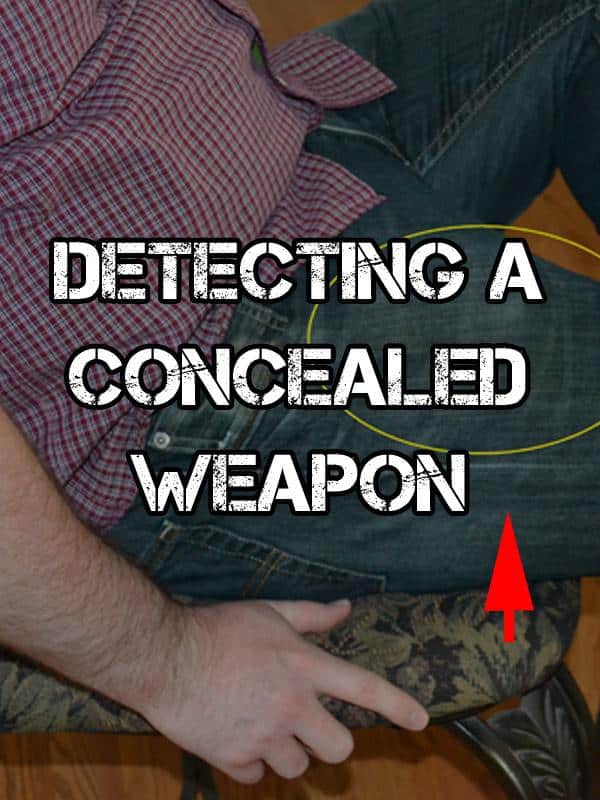
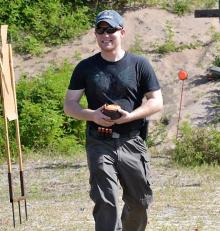
Chad Nabors specializes in firearms, with a strong focus on concealed carry and pistols. His background is in commercial sales and training, and armor development and testing. He has trained many citizens on the pistol from basic to advanced skills. He is a vociferous proponent of the 2nd Amendment, and believes that defense of self and family is a moral obligation. He can be reached at grimgunner (AT) gmail.com.

Thank You;
As a CCW carrier, I applaud you for your informational article.
I have helped many a new carrier with their “20 questions” and obtaining their permits.
This will definitely be a required “hand-out”.
You sharing brought into the light, things that are many times over-looked, taken-for-granted, not
taken into consideration…or “just-not-taught” by many instructors…not saying as “bad”…just…many times, assumed and not taught…that’s all.
A very good reference for the “shooter’s library”.
Thanks…again
Hi Charles. Thank you very much for the praise, and I am glad to hear you found the article useful.
In Wyo in the Fall it’s usually the long black metal tube hanging from their shoulder that says Remington 7MM Mag or 300 Win Mag. that gives them away. Either that or the holster with the walnut grips sticking out. The rest of the year the T shirt that says “Kill them All: Let God sort them” is a good clue. I just use the overall rule that if they are over 14 their packing. Works mostly.
Thanks for reading, Paranoid. Yes, the proponents of the open carry lifestyle never make themselves inconspicuous, that much is sure.
Your rule about assuming everyone is armed is not a bad one.
It’s a magazine, not a “clip”. Don’t be like the MSM. Just don’t.
Smitty, I appreciate your fanatical adherence to proper nomenclature, “clip” was only used in the body of the text to refer to an attachment system for a holster, sheath or pocket knife, and not a pistol magazine.
Thanks for reading.
Mr. Nabors, great article!! And darned good points. I’ll state, I carry. I’m to be 64 this summer and have conceal carried since I was 21. Yeah, talk about it being a habit. And that alone makes me realize that I’ve a lot to learn still. Most who know me, know I carry. But, interestingly enough, those same people will often ask me if I am “at this time… carrying a gun”. Habit is habit. And that is what I stress to those who decide to legally go armed through this life. It must be something that you stop thinking about in a way. Just a part of getting dressed and putting the ‘pocket stuff’ in the appropriate locations. Billfold, neckerchief/handkerchief, comb, pocket-knife, ….. whatever you consider your daily ‘load’. And firearm and ammunition of course. Habitual acts only become engrained as the years go by and you actually do have a weapon on you every single day. You get so used to it that it becomes just normal. And that to me is the lesson I took most from your article. Most do NOT carry everywhere and they feel it not normal when they do. The offsets of body, movements and such – boy, are you right. I’ve seen it myself. For those who decide to exercise their right to be and go armed – do so; just do so every single day and allow it to be just something like 2nd nature….. having your comb or whatever in your pocket. The American Express adage, “don’t leave home without it”. When you cease to feel ‘aware’ that you’re armed; rather, you’d feel different if you weren’t — you’re just about there.
Heartless, thanks for the praise. I am glad you found the article informative.
You are correct that many “new” carriers of weapons, especially guns, will exhibit signs of awkwardness or nervousness; that feeling that, no matter how small or how concealed, EVERYONE can see your pistol is tough to shake. I have dealt with a few students who were chronic worriers about that.
The trick is to make carrying it as natural as your wallet, but to maintain the sharpened awareness that it demands. I know you too have seen the folks who go too far in the other direction; complacent carriers who conceal the gun only as much as law demands. They aren’t fooling anyone, and that may come back to bite them, to say nothing of “scaring the horses.”
Thanks again for reading, take care.
Yep, after 10 years a cop, I might be getting a bit complacent! Thanks for the great article, always good to learn more on the subject.
Great reply, thanks for the grins and the final statement.
“Don’t mind me! The jig is up, and someone needs to leave the premises.” That really made me LOL.
I just moved from Maryland (which has strict laws and a permit needed to purchase anything that’s not a shotgun) to Pennsylvania, where it’s much more relaxed. I did get my MD permit before moving (very proud day for me) and as a responsible gun owner used to living in a place that totally demonized them it’s nice to see the good ol’ boys with their concealed carries at the store. I always prided myself on making myself aware of my surroundings and I bet I can spot a concealed carry better then the average bear but it’s always nice to learn more.
I have to admit though, if someone dropped a concealed gun in the ladies room my heart might skip a beat LOL! Maybe more common in the men’s room?
Good article. Thanks!
Hey, Rachel. Glad you found the article informative, thanks for taking the time to read it.
Regarding your restroom query, while I do not frequent the ladies’ room, I will presume that the preponderance of women who choose to carry in a purse will make this a somewhat less likely event than in the men’s room. That being said, anyone who is utilizing a belt mounted holster, IWB or OWB, are at risk of dumping the gun (sorry, poor choice of words) when they unbuckle or loosen their belt due to lessened tension on the gun or holster.
More women carry on the belt or otherwise at the waist than you might think, so chances are you’ll encounter this unfortunate phenomenon before too awful long now that you are in a permissive environment.
Stay safe out there, and thanks for commenting!
After having committed this faux pas a time or two early on in my “carry walk” I finally realised what the problem was. As you described above, the release of the belt/waistband burron results in a sudden change in the tension on the gun itself, leaving it much more free to dislodge and make this strange clatttering noise as it contacts the tile floor.
Hmm..HOW to prevent?!?!? Simple. As I release the tension on te belt,and before beginning to lower the trousers, I will grab the holsterwith the gin inside, retaining tension with the belt to hold the gun in, then, actually gripping the holster, use IT to lower the whole shebang to my ankles. Reversing the proceedure, I grasp the holster itself, first making certain the gun in holster is properly oriented to easily travel up to its usual place on my waist, snuggle it into its riding space then tighten and buckle the belt. I will often back myself up against a wall or the handbars to hold the weight of the whole mess as I adjust it and finish up the belt attachment. Since I’ve taken up this habit I’ve yet to hear that strange clatter….. been a few years now.
I certainly wished SOMEONE had taken the troubble to present an article with drawigs or even a video, of HOW to manage a heavier carry gun as one takes care of one’s busines in the loo.We LL have to do that at times. Figuring it all out on my own was quite the adventure. I had no close friends who could help,as most of them had no interest in working out the logistics and patterns of everyday everywhere carrying.
I find the fanny pack advice to be overblown. If you see a young fit man with one, he probably has a gun. Where I live, however, all of the old women and most of the old men carry them. I seriously doubt that all of these people have guns in there. They are a lot more convenient and more secure than a purse and much more capacious than pockets. And they carry them in front for convenience and security. Range of motion is often limited for old people.
I thought it was curious too, but I do understand the reason why to be wary around the use of a fanny pack. For me, I use one when I’m wearing athletic shorts that just won’t support the weight of my CCW. But of course the sag, etc. of other indicators will show without a doubt. But, I’d rather do that than not be safe. The other drawback too is the time to draw and often the brand who make them just have to put a tag or label on indicating their brand and those who know… know.
But the low IQ idots won’t since they can’t think of consequences. Often I don’t mind when I notice other well meaning 2A Patriots using their God given rights.
It’s an interesting thought exercise to consider how much ‘printing’ matters. I suppose it gets down to how subtle it is and the ones aware enough who notice are the ones to worry about… Low IQ I don’t worry, fellow Patriots, I don’t worry, but these days, it could be those whom get paid by our taxes which could ultimately be the problem.
Stay Safe and Frosty frens. I just found this blog, thanks for your efforts!
Thanks for the very informative article. I don’t know how common it is, but there is another CCW “tell” that you did not mention. And that is the “smell tell.” Some products used for gun cleaning and lubrication have an unmistakable smell. Hoppe’s number 9, Break Free CLP, and Kroil for example all have a very distinctive smell that cannot be mistaken for anything else. The user of these products will become accustomed to the smell, much like a smoker, but anyone catching a whiff who is wise to what causes the smell will immediately know that someone in the room is probably armed. It is partly for this reason that I have switched to Lubriplate, a product made to lubricate machinery used in the food preparation industry. As such it has no distinctive smell (or, I assume, taste). I know it sounds a little wonky, especially when most folks seldom notice even open carry, but those who go out of their way to look for hidden weapons can be especially troublesome: criminals, anti-2A shop keepers, and social justice warriors who think it’s entertaining and completely justified to “SWAT” a CCW holder. Avoiding that sort of trouble, any trouble really, is how I prefer to go about my business.
As a mechainc I often use Kroil or a knockoff that’s half the price (and 98% as effective) but never on my guns. Rem Oil or MbSO2 (dry lube) go there. But I suppose you DO makena valid point.. what else wouldexplain the sudden appearance of any of those distinctive smells in, say, a restaurant or theatre setting?
Watch for clothing or cars displaying gun related logos, phrases, etc. NRA, Glock, IDPA, etc. Also tactical vests aka “shoot me first”, and 5.11 branded clothing.
Yup. Often they have great products, but remove the tag and they should know better not to put them on the garments FFS.
Additionally, putting stickers on your vehicle related to any types of weapons really is just asking for windows to be broken. . . Grey man concept has been true for decades tbh, but people still do. Oh, Kimber lover? Let’s find out!
Great article. I’ve thought of some of the observations in the past but your article really pointed out some additional areas of concern that are not always obvious.
Concerning “dropped in the Men’s room”, the instructor I got my CCW class from, recommended to thread your belt backwards, so the buckle will be on the holster side, helps keep every thing in place when unbuckled.
Great article, but I got a little tickled early in the article when you said, “12:30 to 6” for people to spot guns or knives. This might be one of the very reasons I carry where I do much of the time. I’m in a very public, very visible, in-front-of-people, type situation constantly, but where I really don’t want my gun visible. Many of the people know I’m carrying because I manage our group’s security and I’ve often been asked by friends where I’m carrying. For years I’ve worn I SmartCarry holster and carry a full size pistol at 12:00. No one looks at a guy’s crotch and if they did see a bulge would think nothing of it. It isn’t as fast to draw as the hip holster I carry in the woods, but I’ve never had anyone detect it. The fact I have a bit of a bulge all the way around above my belt is only camouflage for this holster, where it accentuates anything carried on my waist. Whether I’m wearing light weight summer trousers or heavy jeans, this holster keeps my gun secure and invisible.
Alternatively, when wearing a dress shirt, I wear a 5.11 holster undershirt which conceals my full size pistol against my traps underneath my rather wide Teres Major muscles. My shirts are full cut so they never print, but people have encountered it when hugging me… but I’ve never had anyone comment on it. The only time this is visible is when I’m sitting and the barrel end then rests just above my belt, protruding out an inch, so the shirt fabric can’t collapse against me.
I’m one who is like you, constantly scanning for weapons and then observing the people–which I’m doing whether they are likely armed or not–and anticipating scenarios. But I’ve been taught this lesson by force, having been mugged on three continents. (places I was not permitted to be armed) And in each of those instances it happened so quickly at such close range that a gun wouldn’t have come into play anyway and I had to deal with the situation with my hands and feet and head. Those who carry should never assume that gun will always be the answer to a conflict or that they will even be able to use it in such a situation.
Jo – I think you need to review your anatomy, bro. If your gun is in contact with your teres major (or minor for that matter) or any part of your traps you have it taped to your upper back like John McClane on Die Hard. Pretty sure that is not how 511 holster shirts work. LOL